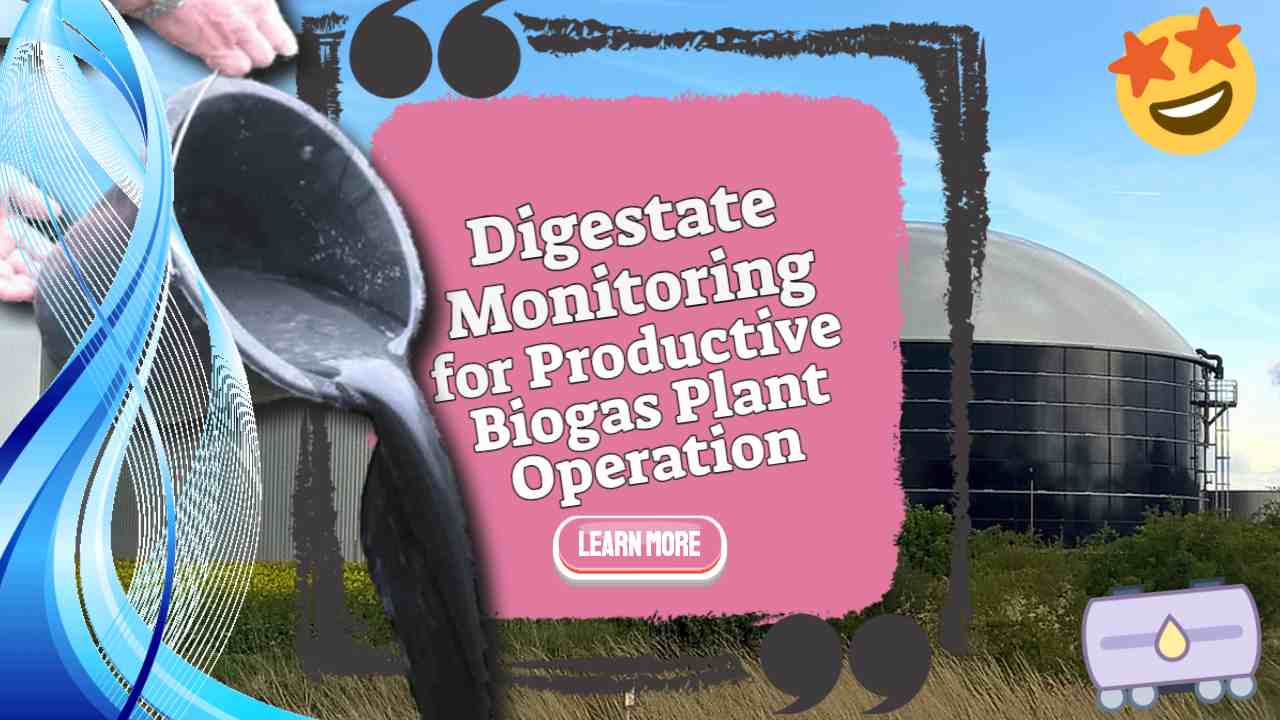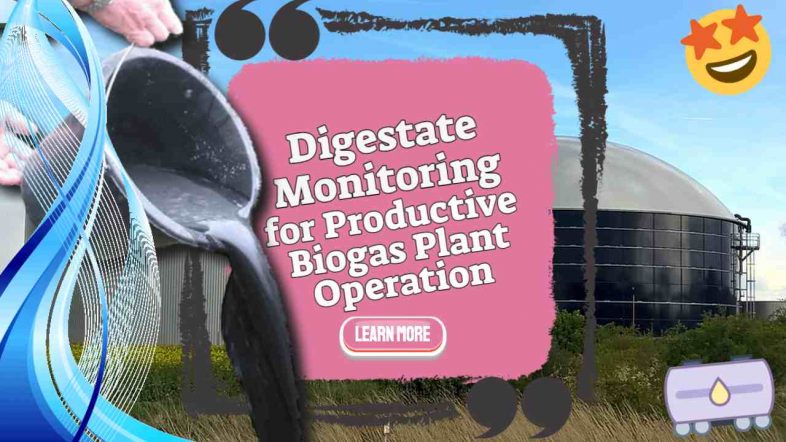Very few people have written about digestate monitoring for productive biogas plant operation, but careful sampling and analysis of the digestion process is essential for any commercial anaerobic digestion process. It's essential, to reliably achieve high methane yields and the lowest downtime periods.

By referring to digestate monitoring in this article, we also make the assumption that the term is synonymous with “digester substrate monitoring, which in principle is for the most common digester type, which is the CSTR type of anaerobic digestion plant process.
The CSTR (Continuously Stirred Tank Reactor) using a single tank is simple to monitor in this way by analyzing the digestate as it leaves the reactor.
For other reactor types, such as:
- Plug Flow Biogas processes and
- Dry AD Systems,
there is a similar level of importance, but multiple monitoring points may be needed.
The Importance of Digestate Monitoring
Understanding the anaerobic digestion process as an ongoing and ever-changing dynamic process. It is the key to reliable AD plant operation, even for very constant and seasonally non-varying feedstocks.
Operators need to know when important parameters are out of the normal range before a biogas reactor shows a significant slowdown in yield. That way, the operator can act to correct them before the health of the productive methane-producing microorganisms declines.
A purely responsive approach to digestate monitoring may be a tempting strategy to keep monitoring costs down, but it has been shown to incur a net loss when biogas yield slowdowns occur.
This fact becomes ever more relevant as the value of the methane produced by the AD industry rises.
Would You Ask Any Doctor for Reliable Diagnoses of Any Illness Without a Knowledge of What's Wrong?
How can you, as the biogas plant operator, make it better if you don’t know what the ailment is?
The analogy here is that for the diagnosis of any stomach complaint, your doctor would need to know about your:
- Diet; What and how much are you eating? – which for an AD plant, is the feedstock
- General health and any other medications that are taken by the patient – AD plant dosing, enzyme addition, etc.)
- The exercise you are taking (digester agitation, etc.)
- Full details of the symptoms of the illness.
Knowledge of the above through digestate monitoring and proactive process management allows for successful corrective action before the process output suffers significantly. The worst of all scenarios of a sour digester, and the need to remove part of all of the digester contents, before resuming methane production is avoided.

Let's look in more detail at the important “digester diet,” firstly from the point of view of feedstock quality and throughput quantity, and secondly by considering what we call “quality pointers”:
1. Digester Diet: Feedstock Quality and Quantity Data
Using our “human” analogy, “diet” doubles for the biogas digester's “feedstock quality and quantity.” Feedstock quality is a lot about its consistent organic content and quantity.
Get these two right, and the biomass will operate at a consistent temperature and will tune itself to optimally digest that material. This is the industry's general experience. But it is best to monitor to ensure that all the most important parameters that affect methanogen viability, are present in concentrations that allow healthy digestion.
Good productive “healthy digestion” in the digester needs a consistent feedstock at a controlled viscosity, or at least a viscosity within known boundaries of biomass toleration.
For this to occur:
- Particle size and maceration (chopper length) need to be controlled, and the equipment needs to work as intended.
- Contaminants present in the incoming feed need to be held within limits that are tolerable for the mechanical operation of the process.
- Plastic input needs to be largely removed, especially bags and films that can seriously impede stirring.
- Other unwanted items need to be removed before maceration or mechanical processing. And, to make it clear, what can go wrong. Almost unbelievably, there have been occasions when even large objects, such as tyres, etc., have been found in feedstocks!
In short, any diagnosis needs a full understanding of the feedstock at the time of the methane yield problem and for some months previously.
2. Digester Diet: Quality Pointers – Testing and Observation
In effect, understanding the biomass growing conditions is essential to being a biogas “doctor,” and continually monitoring the process should, for most biogas businesses, include:
- Observing what’s coming in
- Silage sampling
- Testing tanker loads
- Retaining samples for comparison
- Changing Dry Matter (DM) in feed
- Changing the C: N ratio
- pH and available pH buffering capacity within the digestate
- Avoiding ammonia buildup to cause possible methanogen inhibition.
3. Key Chemical Parameters to Monitor Regularly in Digestate
The HACH Company, a leader in water analysis technologies, suggests that monitoring the FOS/TAC (volatile fatty acids/total alkaline capacity) ratio is a very effective way to precisely control the anaerobic digestion process.
This recommendation is grounded in several key advantages that make the FOS/TAC ratio an indispensable tool for optimizing biogas production and maintaining system stability. Here is a summary of the main advantages:
- Enhanced Process Stability: Monitoring the FOS/TAC ratio allows for the early detection of imbalances in the anaerobic digestion process. By keeping this ratio within optimal ranges, operators can prevent the accumulation of volatile fatty acids (VFAs) that could lead to acidosis, a condition detrimental to methanogenic bacteria. This early detection and correction capability ensures a more stable and efficient digestion process.
- Optimized Biogas Production: The FOS/TAC ratio is directly linked to the health and activity of the microbial community responsible for biogas production. Maintaining an optimal ratio ensures that the microbial processes are occurring under favorable conditions, leading to enhanced biogas yield and quality. This is crucial for facilities that rely on biogas as a renewable energy source.
- Cost-Efficiency: By preventing process imbalances and ensuring the anaerobic digester operates efficiently, the FOS/TAC ratio monitoring can lead to significant cost savings. This includes a reduced need for corrective chemical additions, such as alkalis to counteract acidity, and minimized downtime due to process failures. Moreover, optimizing biogas production can increase energy output, thereby enhancing the economic viability of the anaerobic digestion facility.
- Simplified Operation: The FOS/TAC ratio provides a clear and straightforward indicator of the anaerobic digestion process's health, making it easier for operators to make informed decisions. This simplification of process monitoring can reduce the training requirement for plant personnel and streamline daily operations.
- Environmental Compliance: By ensuring the efficient operation of the anaerobic digestion process, FOS/TAC ratio monitoring helps in meeting environmental regulations related to waste treatment and renewable energy production. This can be particularly important in jurisdictions with strict standards for waste processing and biogas emissions.
- Adaptability: The FOS/TAC monitoring technique is adaptable to a wide range of anaerobic digestion systems, regardless of the feedstock type or system size. This versatility makes it an attractive option for various applications, from municipal wastewater treatment plants to agricultural and industrial biogas facilities.
Finally, the HACH Company suggests using the FOS/TAC ratio to manage the anaerobic digestion process. This provides a complete way to keep the system in balance, make the most of biogas production, and make sure operations run smoothly.
These advantages make it an essential tool for operators seeking to maximize the performance and sustainability of their anaerobic digestion facilities.
Conclusion to “Digestate Monitoring for Productive Biogas Plant Operation”
In this article, we have explained the importance of regular digestate quality monitoring of key parameters coupled with a regular review of the data obtained, leading to corrective actions taken.
The list of analysis requirements should be closely attuned to your type of feedstock and digester design. The frequency of sampling should be based on your situation.
FAQs on Digestate Monitoring
1. What is Digestate Monitoring?
Digestate monitoring involves the analysis of the by-product of anaerobic digestion processes to ensure optimal operation conditions, enhance biogas production, and minimize downtime. This includes testing for parameters like pH, nutrient content, dry matter, and potential contaminants.
2. Why is Digestate Monitoring Important for Biogas Plants?
- Process Optimization: By understanding the composition of the digestate, operators can adjust the digestion process to improve efficiency and biogas yield.
- Regulatory Compliance: Regular monitoring helps in complying with environmental regulations concerning digestate disposal or use as a fertilizer.
- Plant Efficiency: Monitoring helps in detecting issues early, reducing the risk of downtime and maintenance costs.
3. How Often Should Digestate be Monitored?
The frequency of digestate monitoring can vary based on the scale of the operation, input materials, and local regulations. However, the absolute minimum for any commercial biogas facility is to perform basic monitoring (pH, dry matter) weekly and more comprehensive analyses (nutrients, contaminants) monthly.
However, an increasing number of biogas plant operators are carrying out real-time automatic sampling every few hours, and reporting improved digester efficiency as a result.
4. What Parameters are Important in Digestate Monitoring?
- pH Level: Indicates the acidity or alkalinity of the digestate, affecting microbial activity and plant health.
- Nutrient Content: Essential for assessing the digestate's value as a fertilizer (N-P-K values).
- Dry Matter: Helps in determining the appropriate handling and application methods.
- Contaminants: Important for ensuring the safety of digestate used as fertilizer.
FOS/TAC monitoring goes beyond the simple data obtained above and can pay off handsomely.
5. Can Digestate be Used as Fertilizer?
Yes, digestate can be a valuable fertilizer due to its nutrient content. However, it's crucial to test for contaminants and follow local guidelines on application rates and methods to ensure environmental safety and crop health.
6. How Can I Improve the Quality of My Digestate?
- Feedstock Quality: Ensure high-quality and consistent feedstock to maintain a balanced digestion process.
- Process Monitoring: Regularly monitor and adjust the anaerobic digestion parameters to optimize microbial activity.
7. What are the Challenges in Digestate Monitoring and Management?
- Variable Composition: The diversity of feedstock types can lead to variability in digestate composition.
- Regulatory Requirements: Adhering to local regulations regarding digestate treatment and application can be complex.
- Logistical Considerations: Handling, storing, analysing, and using digestate monitoring equipment, especially in large volumes, requires careful planning and resources.
8. Where Can I Get More Information on Digestate Monitoring Techniques?
For detailed guidance and best practices on digestate monitoring, consider reaching out to:
- Professional Associations: Organizations such as the Anaerobic Digestion and Bioresources Association (ADBA) offer resources and advice.
- Academic Institutions: Universities conducting research in anaerobic digestion may provide technical publications and support.
- Industry Experts: Consulting with companies specializing in biogas plant operation and waste management can offer customized solutions.
[First published in May 2021.] [Updated and FOS/TAC section added March 2024.]




